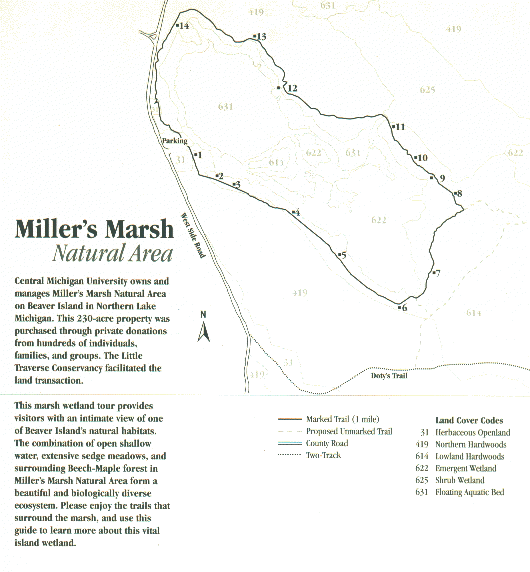Miller's Marsh Natural Area Trail Guide
Central Michigan University Biological Station on Beaver Island
No hunting or overnight camping without permission
The trail guide was created and produced in paper copy (available at the CMU Biological Station) through a grant from the Frey Foundation. Thank you to Dr. Jim Gillingham for permission to use this guide on the website.

Trail Guidepost Key
-
1. This large tree is a Sugar Maple, Acer saccharum. In fact, most of the trees in the area are Sugar Maples. These trees, along with the American Beech, Fagus grandifolia, make up one of the most abundant deciduous forest trees in Michigan. There are the largest trees to border Miller's Marsh and are responsible for attracting much of the wildlife associated with this area.
-
2. Depending on water levels, to your left you can see either a peninsula or an island extending northward into the main water body of Miller's Marsh. This area of land is slightly higher than the marsh itself and is dominated by several White Pine trees, Pinus strobus. In June this area is a favorite birthing area for White-tailed Deer, Odocoileus virginianus.
-
3. You are now in the midst of a small grove of Hemlock Tsuga canadensis. This tree is typical of the northern latitudes where well-drained soils are prominent and where hard, cold winters are standard. Hemlock possesses a particularly dense wood, which has a multitude of uses in the building industry.
-
4. This site is notable for the large American Beech, F. grandifolia, which is quite hollow but still is alive. Such a tree is important, as it provides hollows and cavities for a variety of animals.
-
5. This very large tree beside the trail is a Yellow Birch Betula alleghaniensis. It can be identified by tasting its twigs and detecting the oil of wintergreen!
-
6. This site indicates the presence of an early pioneer's hand-dug well. Early homesteaders had no choice but to dig their wells by hand. They lined the wells with field-gathered stone to avoid sedimentary contamination and to prevent the sides of the walls from collapsing.
-
7. This area is home to a large number of plants that carpet the forest floor and look like miniature Pine Trees. Actually these are very "primitive" plants known as "Club Mosses" within the genus Lycopodium. Because of their small size and resemblance to conifers, they are known in the vernacular as "Princess Pines."
-
8. To the right of this site, one can easily see the channelized waterway made by the Beaver, Castor canadensis. The Beaver uses these waterways during all seasons, but they are particularly important during the winter. Movements underwater become more important during this season as these mammals swim from their dens to their underwater summer caches of twigs, branches, and leaves.
-
9. The tree blind at this site is used by sportsmen during the fall to hunt for White-tailed Deer, O. virginianus. Biologists use this blind during the spring and summer seasons to observe wildlife behaviors.
-
10. At this point you are walking through a grove of trees composed mostly of the beautiful Paper Birch, Betula papyrifera. These trees are classified as an early successional stage, which means that, following a clearing of the area, they are one of the first types to establish their dominance.
-
11. To the right, notice evidence of Beaver, C. canadensis, activity. This large rodent has chewed and cut this tree. This activity often is conducted as maintenance of the proper occlusion of their large, prominent incisor teeth. Chewing on wood provides a mechanism to bring about an even wear between the upper and lower incisors.
-
12. On your left at the very margin of the marsh you will observe a beaver lodge. This structure is the year-round home of a family of Beavers, C. canadensis. Whatever the season, this mound allows these mammals to reside above the water level but still have access to their underwater channels for foraging purposes.
-
13. This area is covered with a variety of wetland vegetation, mostly dominated by sedges. They represent an important component of marsh plants and are characterized by having three-sided or triangular stems. "Sedges have edges!"
-
14. You almost have completed a loop of the marsh and again find yourself in a Beech-Maple climax forest. Due to the specific characteristics of the soils here, this vegetational association between these two trees (American Beech, E. granidfolia and Sugar Maple, A. saccharum) represents the final type of vegetation that will inhabit the area. These trees ultimately become the dominant forms of woody vegetation in the area due to their specific characteristics of shade tolerance and wide range of moisture tolerance.